This Jerusalem Artichokes Braised in Olive Oil, Zeytinyagli Yer Elmasi as we say in Turkish, is a simple vegetarian side dish from Turkish cuisine. It is packed with the combination of citrus and olive oil flavors.
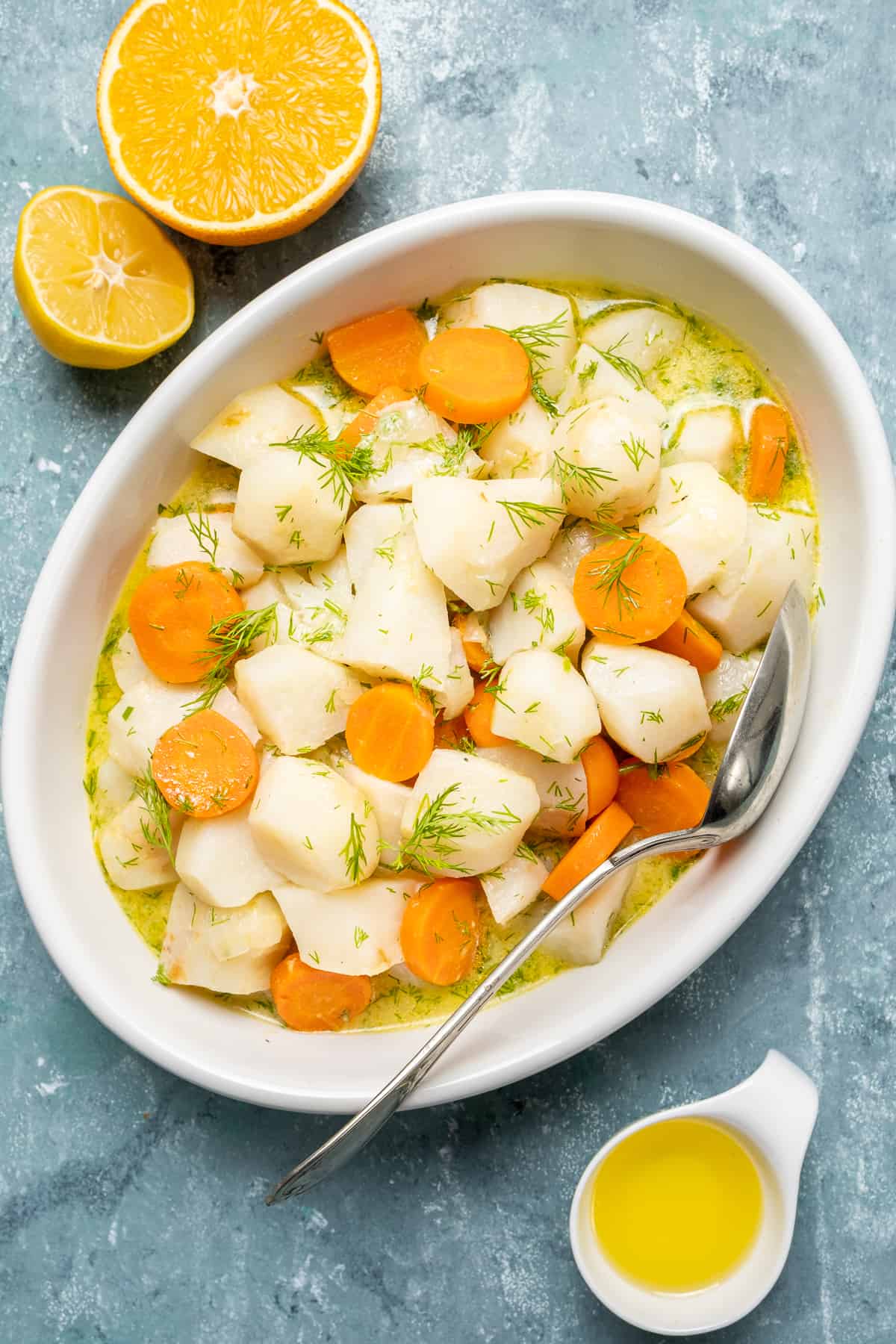
This recipe is a perfect combination with the earthy and nutty flavor of sunchokes, also known as earth apples (yer elmasi in Turkish). It is healthy and extremely easy to make. It can be served hot or at room temperature. You can have it as a side or a vegetarian lunch on its own.
Sunchokes or Jerusalem artichokes are a staple during fall and winter in our kitchen. We either eat them raw (yes, they can be eaten raw!) or make this easy Turkish recipe. It is one of our favorite vegetarian dishes.
What are Jerusalem Artichokes (Yer Elmasi)?
This unique vegetable goes by many other names including sunchoke, topinambur, Jerusalem artichoke and sunroot. In Turkey, it is known as "yerelması” which directly translates to “earth apple”, which is another name for it. So we will be using these names interchangeably in this post.
Despite the name Jerusalem artichoke, there is no connection between the city and the vegetable. They have no relation to artichokes, either!
So, what exactly is a Jerusalem artichoke vegetable then?!
It is a type of tuberous root vegetable that is native to the North American region despite being an extremely popular ingredient in many other cuisines and cultures around the world.
So how does a "yer elması" taste? Think of a combination of slightly sweet but nutty flavors. It definitely doesn’t have an overpowering flavor and pairs beautifully with a ton of flavorings.
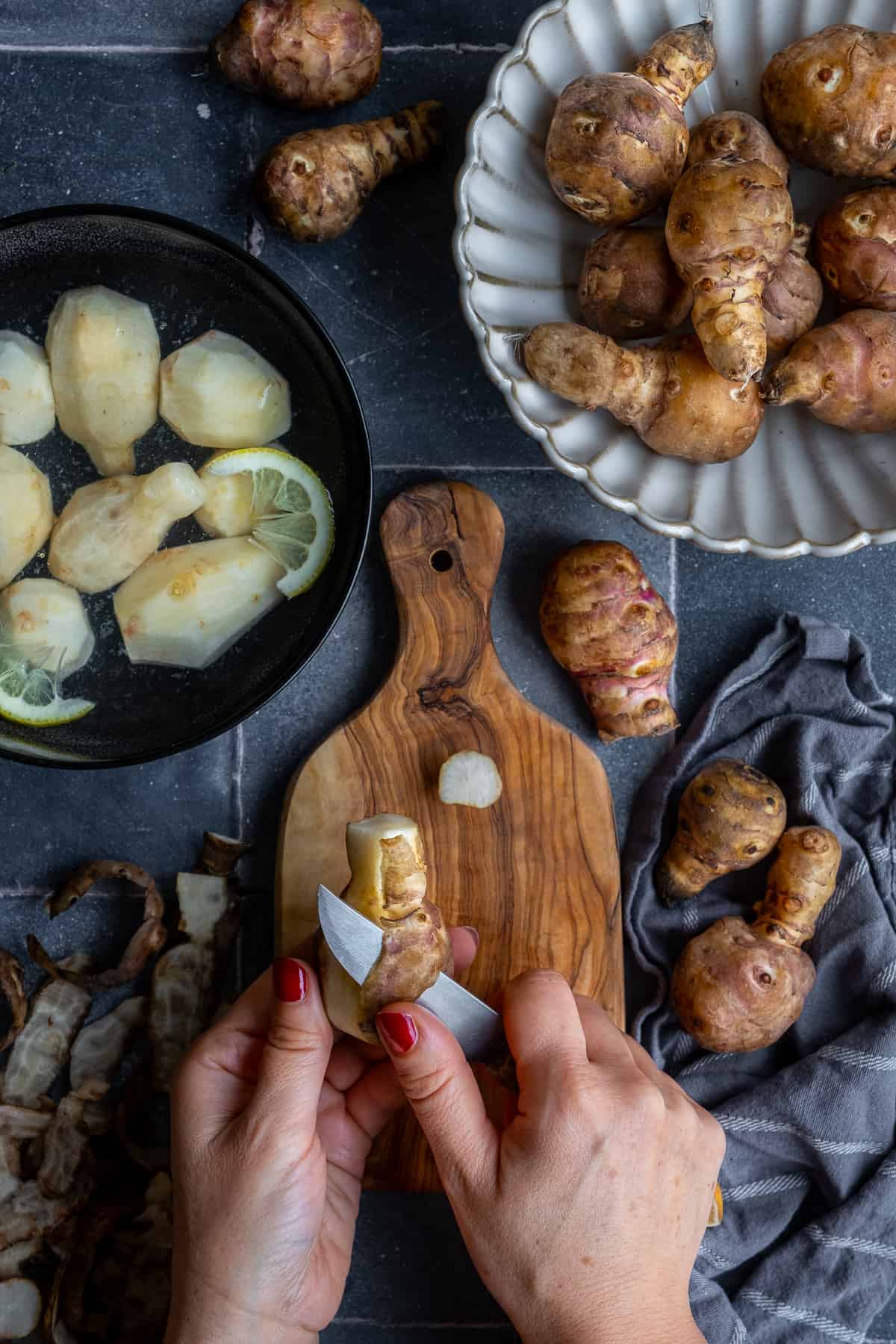
How to Prepare It
Sunchokes have to be scrubbed clean before being prepared. Because they grow underground, a ton of dirt and pebbles get stuck between the ridges of this root vegetable.
We peel sunchokes to be sure that we get rid of all that dirt, but it isn't necessary. The skin is safe to eat. Just remember to wash it very well otherwise you might have to chew on some sand!
The way you cut them will depend on what you’re making with them, but they are very versatile vegetables so can be cut in many different ways (thickness and shapes). You can just chop them roughly when braising them as we do in this recipe or when making pureed Jerusalem artichoke soup.
Today, we will share one of the easiest recipes made with sunchokes, carrots, citrus and herbs: Zeytinyagli Yer Elmasi.
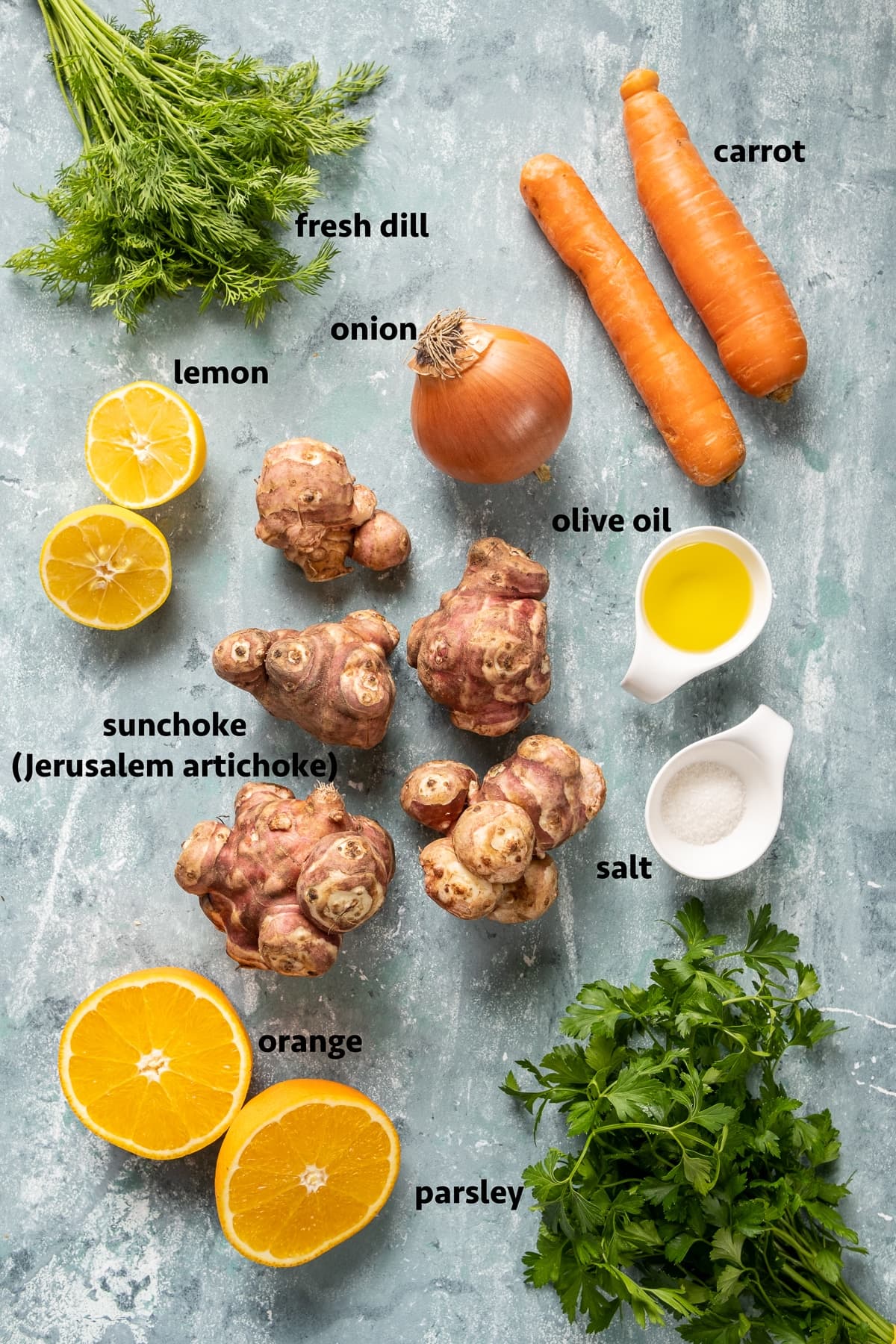
About The Ingredients
Yer elması (Jerusalem artichokes / sunchokes): You can find them at big markets or at farmers markets. They could also be labeled as topinambur or earth apple. We peel them for this recipe but you can leave their skin. Just make sure you clean them well.
Carrots: We think the best vegetable to combine with sunchokes is carrots. They enrich the dish with their subtle sweetness and color.
Citrus flavors: We use a combination of orange and lemon. You can use one of them.
Herbs: Fresh dill is a great ingredient to combine with vegetable dishes like this. Additionally, we sometimes add parsley.
Olive oil: Use a good quality of olive oil. You can even use extra virgin olive oil to drizzle over the dish after it is cooled.
How to Make This Recipe
Now, let's see how to braise yer elmasi in olive oil.
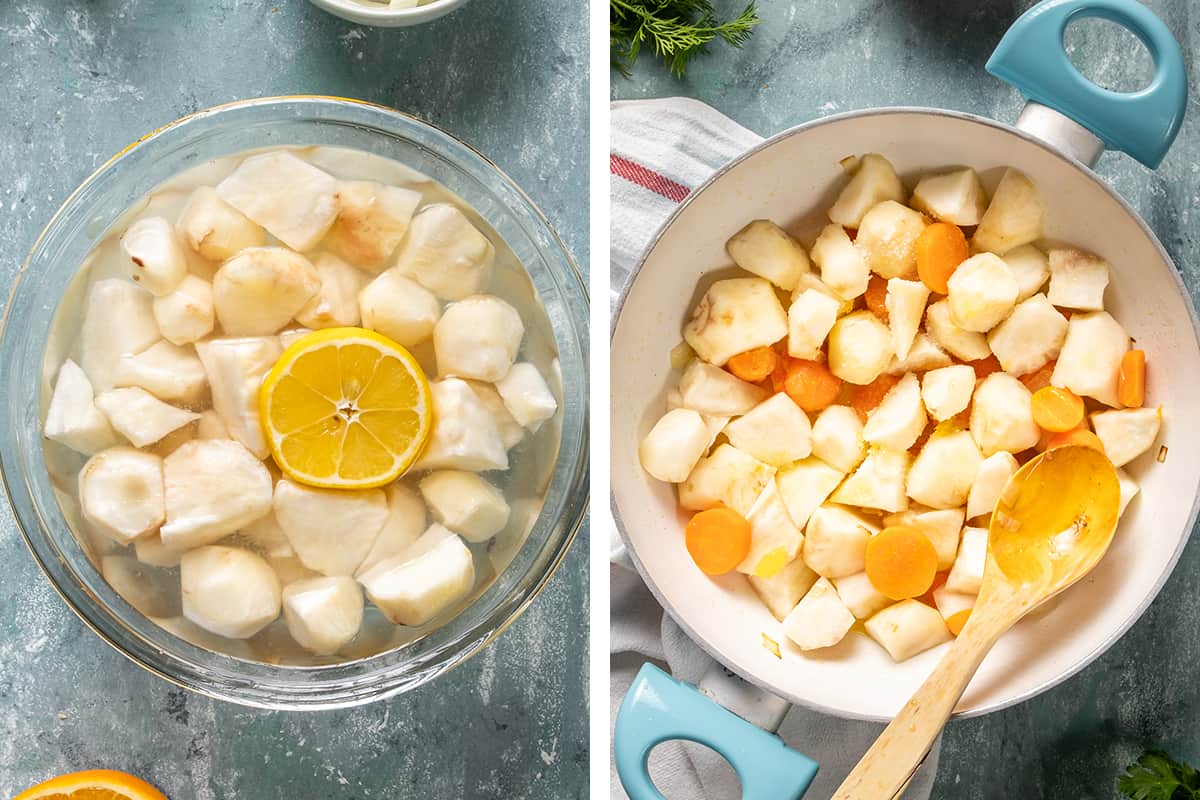
Prepare the sunchokes: Add water into a bowl with some lemon juice inside. Peel the sunchokes and chop them roughly. Place them in lemon water to prevent them from becoming brown or discolored in any way.
Cook the vegetables: In a large pan, heat the olive oil and sauté the onions and carrots. Add the sunchokes with their lemon water along with the orange juice and salt. Cook the mixture covered for about 20 minutes, or until the vegetables are tender and evenly cooked.
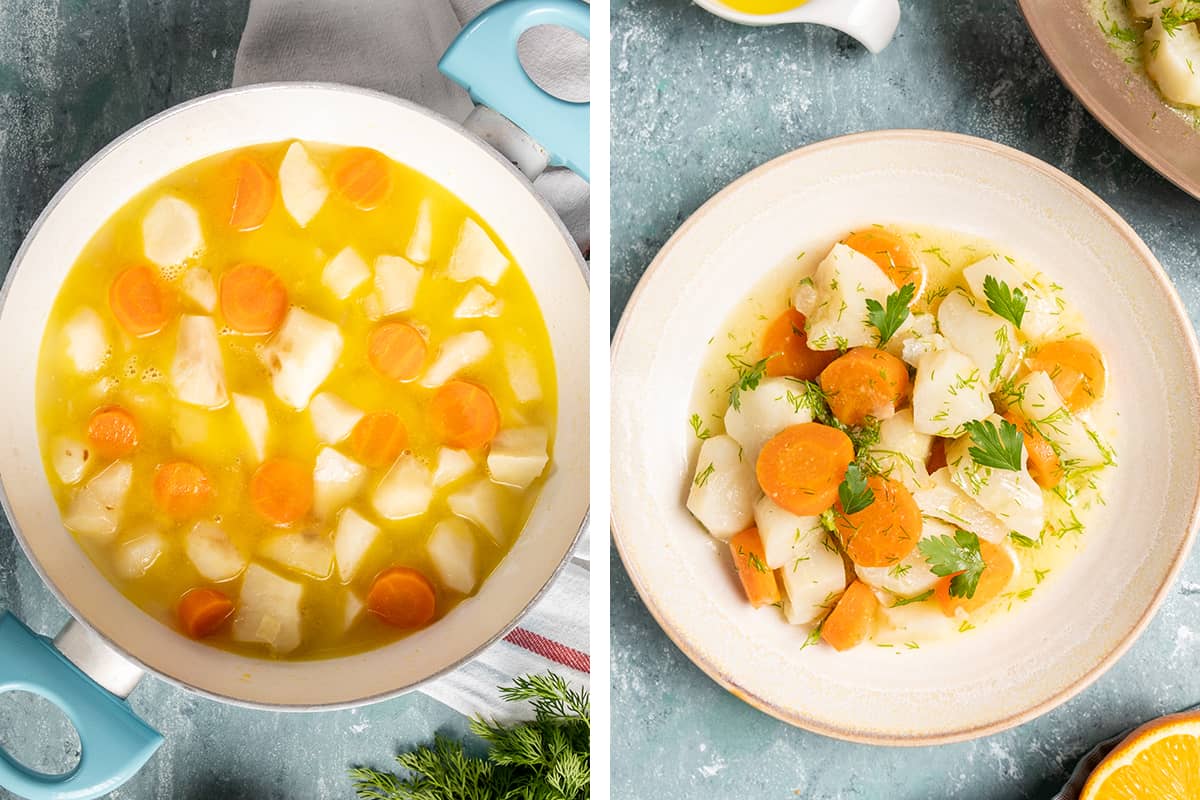
Garnish and serve: Once your vegetables have fully cooked, remove them from the heat, let it cook down a bit and add some freshly chopped dill or parsley. Transfer it to a serving bowl and serve according to your liking.
Remember to add extra olive oil and lemon juice before serving!
Serving Suggestions
Zeytinyağlı Yer Elması, a traditional Turkish dish with sunchokes (Jerusalem artichokes) cooked in olive oil, can be served in several ways:
- As a Meze: Serve it chilled or at room temperature as part of a meze platter. Pair it with other Turkish appetizers like hummus, baba ganoush, haydari and fresh pide bread for a wonderful appetizer spread.
- With Oven Baked Fish: The subtle, nutty flavor of Zeytinyağlı Yer Elması complements oven baked whole fish beautifully.
- With Yogurt Sauce: Top the dish with a dollop of thick yogurt to add a creamy texture and a tangy flavor, enhancing the overall taste experience.
- Alongside Pilaf: Serve it with a side of Turkish rice pilaf or bulgur pilaf. The grains will absorb the flavors of the olive oil and spices, making for a hearty meal.
- As Part of a Grain Bowl: Include it in a grain bowl with bulgar wheat, wheat or buckwheat (for a gluten-free option), adding other vegetables and a dressing of your choice for a nutritious and filling meal.
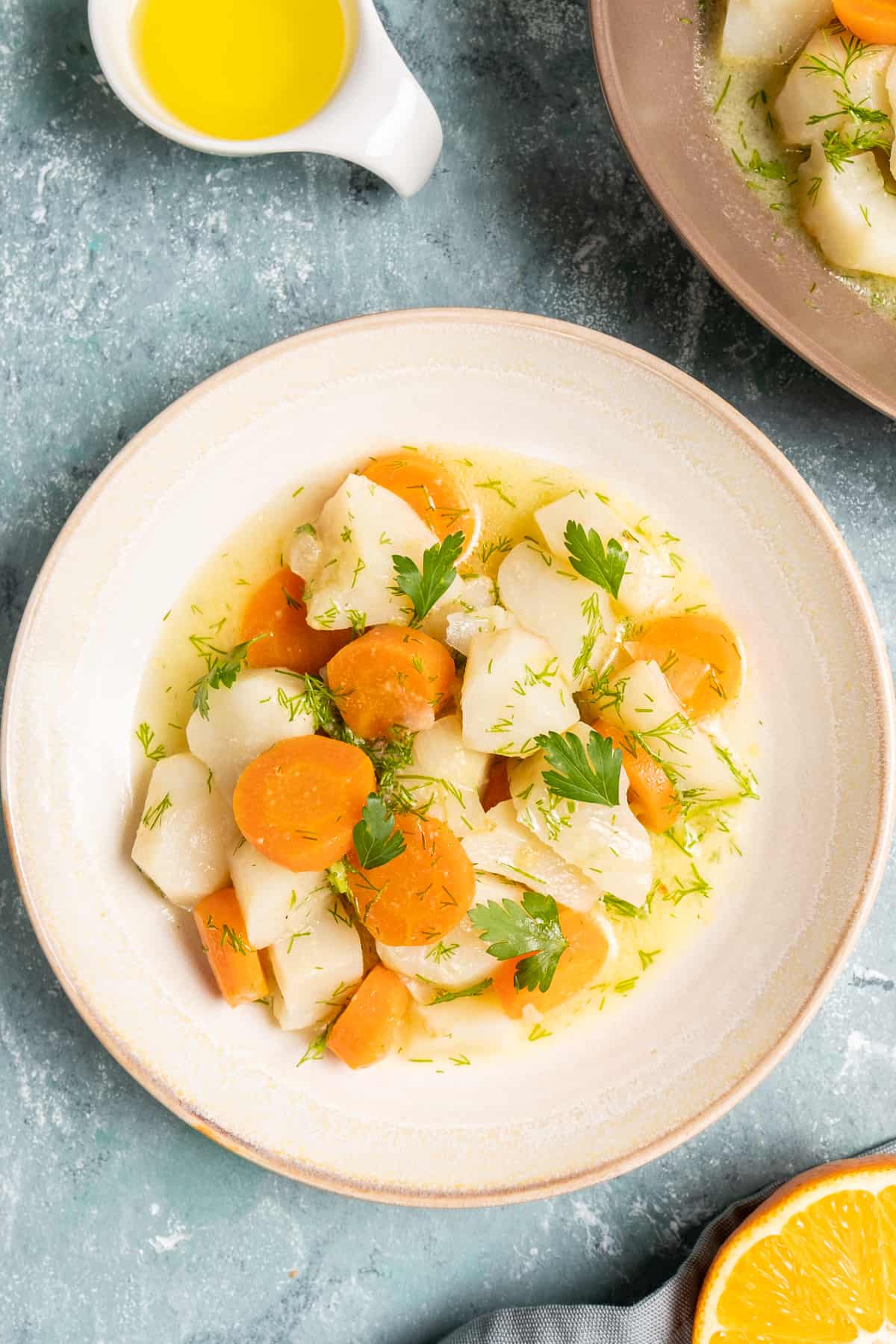
Storing & Reheating
Storing:
- After cooking, let the Zeytinyağlı Yer Elması cool down to room temperature.
- Pop it in an airtight container. Glass containers work great, but any container with a tight lid will do the trick.
- Slide it into your fridge. It’ll stay good for up to 3-4 days.
Reheating:
- Microwave: For a quick fix, just put it in a microwave-safe dish. Cover it with a lid or some microwave-safe wrap (to keep the moisture in). Zap it for a couple of minutes, stirring halfway through. Be careful when you take it out – it'll be hot!
- Stove: Pour a tiny bit of water or olive oil into a pan and add your Zeytinyağlı Yer Elması. Warm it over medium heat, stirring now and then, until it’s heated through.
- At room temperature: Remove it from the fridge and put it on the counter about 30 minutes before eating. Serve it when it reaches room temperature.
Frequently Asked Questions
No, it isn’t necessary. The main reason for peeling is to remove any dirt or sand left on the surface, but as we've also mentioned, those can be removed by simply scrubbing the skin with a vegetable brush or sponge and some clean water.
Sunchokes are generally available from early fall right through to spring, but the optimum time to harvest or consume them is in the winter months.
Yes, you can eat them raw! And truthfully, they’re actually quite delicious this way! They add a nutty flavor and crunchy texture to any salad or sandwich.
More Turkish Vegetarian Dishes
- Yaprak Sarma
- Imam Bayildi
- Bamya
- Karnabahar Yemegi (Turkish Cauliflower Recipe)
- Zeytinyagli Kereviz (Celeriac in Olive Oil)
- Taze Fasulye (Turkish Green Beans)
- Zeytinyagli Enginar (Turkish Style Stuffed Artichoke Bottoms)
You might Also Like
As always: If you make this recipe, let us know what you think by rating it and leaving a comment below. And post a pic on Instagram too—tag @give_recipe so we can see!
Sign up for the FREE GiveRecipe Newsletter to get the new recipes into your inbox! And stay in touch with us on Facebook, Pinterest, YouTube and Instagram for all the latest updates.
📖 Recipe

Zeytinyagli Yer Elmasi (Jerusalem Artichokes in Olive Oil)
INGREDIENTS
- 4 cups sunchokes also known as Jerusalem artichokes, chopped
- 2 cups water
- 1 tablespoon lemon juice
- 1 small onion diced
- ½ cup carrots chopped
- ½ tablespoon orange juice optional
- ½ teaspoon salt
- 2 tablespoons olive oil
- 1 tablespoon fresh dill chopped
INSTRUCTIONS
- Put water in a large bowl. Squeeze lemon in it and put it aside.
- Peel the sunchokes and chop them roughly. Transfer them into the bowl with water. This is to prevent the chopped sunchokes from getting darker.
- Heat olive oil in a pan. Saute diced onion and carrots until translucent.
- Add in the chopped sunchokes with the water in the bowl.
- Pour orange juice over them. Add in salt. Cook covered until the carrots and sunchokes are tender, for about 20 minutes.
- Remove from heat, add in chopped fresh dill, give it a stir and transfer into a serving bowl. Bring it to room temperature.
- Optionally, you can drizzle extra olive oil and squeeze extra lemon on it right before serving.
NOTES
- After peeled, sunchokes lose their bright color fast. To avoid this, put them in a cold lemon water.
- Don't overcook the sunchokes, they will get mushy otherwise.
- Serving suggestion: Let the dish cool completely, keep it in the refrigerator for 30 minutes and then serve.
NUTRITION
Nutrition information is automatically calculated, so should only be used as an approximation.


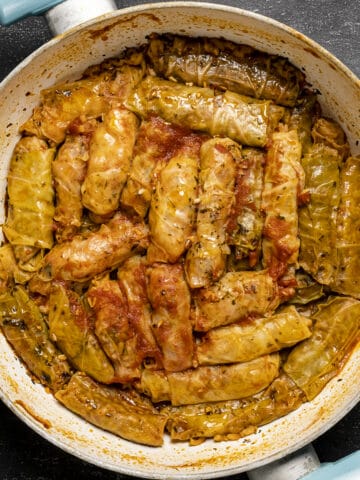

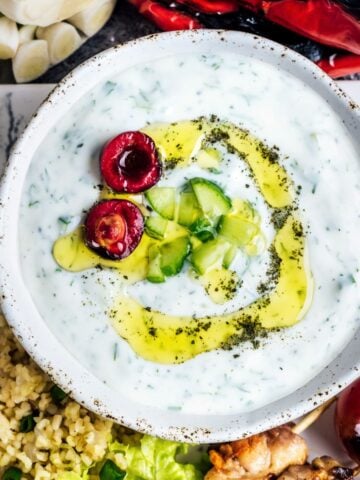
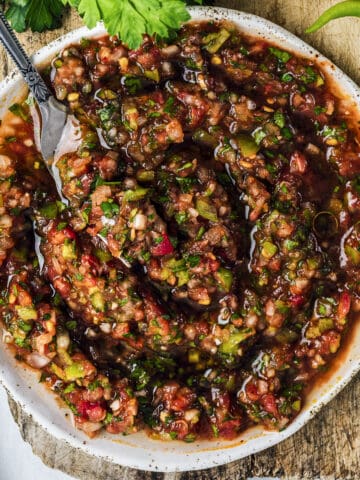
Stephanie says
I saw Jerusalem artichokes many times at markets and had been wondering about them. So glad I found this recipe. Made this today and loved it! We had it for lunch with some rice. Thank you for the recipe!
Yusuf says
Hi Stephanie,
Glad you liked the recipe. It is really easy to make, right? Pairing it with rice sounds great!
Best olive oil in New Zealand says
mmmmmm. looks delicious, thanks for that recipe
Megan Thompson says
Olive oil is very tasty and has some nutty taste too.":`
Azita says
I think I've seen it back home, love to try it one day. Thanks for the recipe, Zerrin.
elra says
Here in the U.S, we called it Jerusalem artichoke. Not sure if its has anything to do with Jerusalem though. For sure, your soup look delicious Zerrrin.